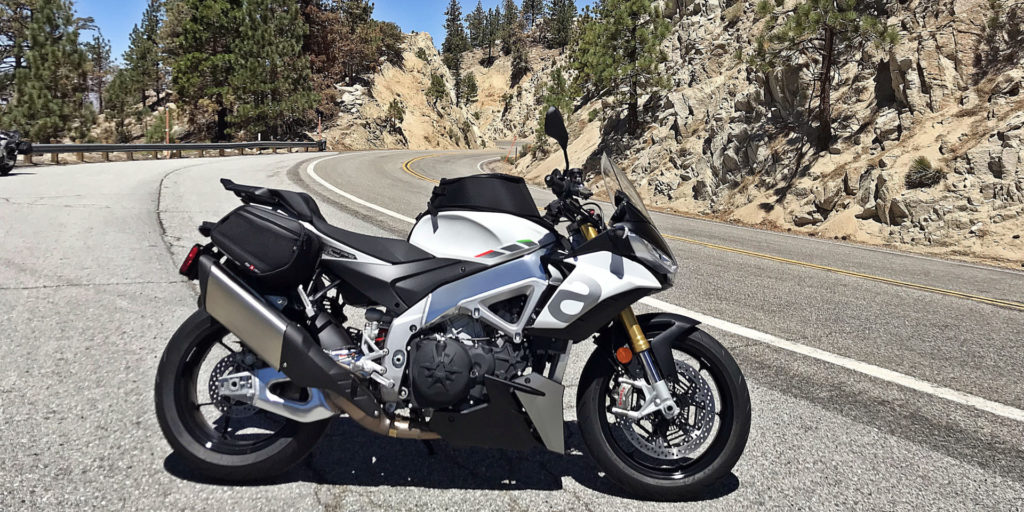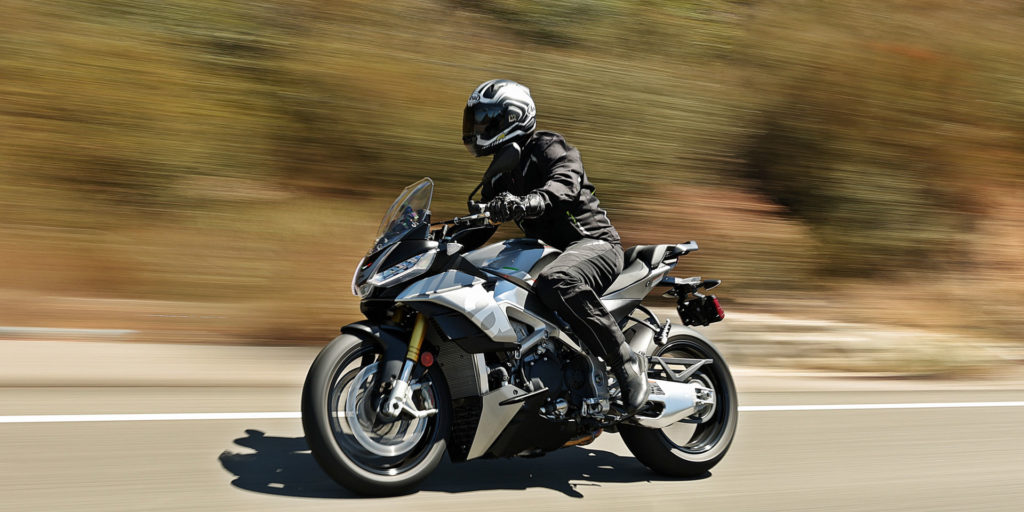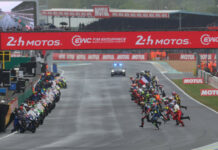Copyright 2021, Roadracing World Publishing, Inc.
By Michael Gougis
When I first rode the new Aprilia 660 RS last year, my first thought was, “There’s no way this thing is only a 660.”
When I first twisted the throttle on the 2021 Tuono V4 Factory, my first thought expressed the same sentiment, just from a different direction. I thought, “This is absolutely an 1100! Woo-hoo!”
It’s a winning formula for Aprilia — take a powerful engine from a sportbike and stick it into a chassis that has a slightly friendlier riding position. Voila, the Tuono, historically one of the company’s most important models.
The 2021 Tuono V4 models refine that idea a bit, with Aprilia offering two similar yet very distinctive models of its iconic “standard “sports model lineup. The Factory version is even more track oriented than the prior RR model, while the V4 version is aimed at the person who rides on the street and wants to rack up serious mileage.
When Aprilia turned a handful of motojournalists loose on the new machines on the roads of the Southern California mountains last week, the glorious sounds of V4 motorcycle engines echoed through the canyons above Pasadena.
Technical Overview
The machine is powered by Aprilia‘s 1077cc 65-degree V4, with architecture it shares with the company’s flagship RSV4 sportbike. Aprilia says the Tuono version has been re-tuned for more mid-range torque, but still puts out a claimed 175 horsepower at 11,350 rpm with a torque peak of 89.25 lbs.-ft. at 9,000 rpm. Aprilia was determined to ensure that compliance with the new Euro5 emissions standards did not reduce overall engine performance.
The rest of the powertrain is very similar to, and in keeping with, the Aprilia V4 sportbike DNA. The engine retains its unique chain/gear camshaft drive system. Lighter valve spring bucket tappets raise the redline from 12,500 rpm to 12,800 rpm.
A new Magneti Marelli 11MP ECU offers more pins (from 80 to 144, to allow for more inputs into the bike’s electronic brain) and four times the computing speed of the prior unit. Rider aids include cornering ABS, traction control, wheelie control, engine braking, launch control, clutchless up- and down-shifting, a pit speed limiter, cruise control, three engine maps, and six riding modes. (You know you’ve got a real all-arounder when your bike has a pit lane speed limiter and cruise control. That’s a broad spread of functionality!)
The cosmetic changes for this model year are subtle, but significant. Both versions get a re-styled fairing, and both versions get a new inverted swingarm based on a MotoGP design and is lighter, simpler to produce, and 48% stiffer. A new tank is featured on both machines, as are LED headlights that light the inside of corners. The changes, or the differences between the two models, are found in the suspension, in the riding position, and in the details.
The Factory model comes with Ohlins Smart EC 2.0 semi-active electronically adjustable suspension, a system which also controls adjustments at the steering damper. On this model, suspension adjustments are made using buttons on the left handlebar and displayed on the Thin-Film Transistor dash.
The windscreen is bobbed, the tubular bars are lower than on the prior model, and at the back of the machine, the Factory utilizes the subframe, passenger pegs, and passenger seating accommodations from the RSV4. For people who have been passengers on the RSV4, those accommodations are a polite way of saying that the rider prefers to travel solo! They have been designed, however, to be removed quickly for track use.
And with track use in mind, the Factory comes with shorter final gearing and a larger (200-series) and stickier Pirelli Supercorsa rear tire, mated to a 120-series Supercorsa front tire.
The base V4 model comes with conventional Sachs suspension front and rear; handlebars lifted approximately an inch via taller risers; a broad, flat passenger seat; and passenger footpegs that are located on longer stalks to offer additional legroom for the passenger.
In addition, the bike is offered with a bespoke set of soft luggage consisting of a remarkably spacious tank bag and a set of saddlebags that are asymmetrical to fit around the exhaust system.
A final touch to increase rider comfort is a taller windscreen than the one found on the Factory and a pair of small side panels that help direct wind blast away from the rider. Taller gearing for more relaxed cruising and Pirelli Diablo Rosso III tires complete the street package.
Suggested MSRP for the base model is $15,999, while the Factory version runs $19,499.
These are important models for Aprilia. Depending on the year, Aprilia will sell between two to three times as many Tuonos as RSV4s. In addition, the Tuono is the model that brings people into the Aprilia brand, and an owner is more likely to hang onto it for a longer period of time than an RSV4 owner. So Aprilia did not take this model revision lightly.

Riding Impressions
As mentioned, the first thing I noticed is the power. It’s everywhere. And while the company’s claims about usable mid-range torque sound so much like a marketing cliché, the fact is that it’s true. The torque produced by this big-bore sportbike engine is a joy, and there in bucketfuls. Pick a gear, twist the throttle, and there’s always enough poke to get moving, quickly. Unlike some other Euro5 machines I’ve ridden, the Tuono still revs quickly and enthusiastically.
Heading up Angeles Crest Highway and on the surrounding roads, I found that I had a choice of gears to play in. I could rev the thing closer to redline in second and let the power at the top pull me out of corners, or I could leave it in third and just ride the torque all the way through the apex, carrying even more speed for a longer portion of the corner and coming out harder on the throttle. Either way provided plenty of speed.

The chassis clearly demonstrated its cutting-edge sportbike roots. The best way to describe this machine’s behavior are responsive and precise, as you might expect from a bike with the RSV4’s chassis and an upgraded swingarm. But I felt every pavement imperfection, courtesy of the very stiff chassis and swingarm. Perhaps it was a function of the more upright tubular handlebars, as compared to clip-on handlebars, but it felt like I could react to those very direct messages from the bike with a light, precise touch. Carving through the corners on the Crest, I felt like I could put the bike anywhere I wanted, even at speed. Between that, the excellent Brembo M50 Monobloc brakes and the ease with which the engine delivers power, it made for a very stress-free ride, even while carrying more than a little bit of speed.
The riding position is definitely more comfortable than on a full-on sport bike. It’s not a naked bike, and is closer to a full-fairing sportbike than a naked. Aprilia‘s philosophy is that a motorcycle going this rapidly needs to provide protection for the rider and aero stability, hence the fairing. And the fairing works, providing a still pocket of air for the rider, lessening the turbulence, and leaving the rider with a more planted feel at the bars.
The clutchless up- and down-shifts work seamlessly, the on-off throttle response is precise and fluid. The clutch pull is a little heavier than I expected after being utterly spoiled by the modern crop of assisted slipper clutches that are now standard on seemingly every motorcycle.
The Factory version felt a little soft and vague when I initially turned into corners, but poking at a couple of buttons on the left handlebar allowed me to dial up one electronic “click” more firmness at the front and at the rear, and, to add a little more resistance, adding one “click” of steering damper. It was an absolute pleasure to ride, with more feedback and feel than most other motorcycles, and the utter confidence of knowing that the bike would do anything I asked it to do.
After lunch, I jumped onto the base V4 model and I was prepared to be disappointed. I can honestly say that I was not disappointed — a remarkable surprise. The Sachs suspension is more than adequate for getting down the mountain at a very, very brisk pace. The more upright handlebars increased the comfort of an already-comfortable riding position, and the slightly larger windscreen provided noticeably more protection.

Aprilia marketeers say that the two new models are based on what they found Aprilia customers were actually doing with their Tuonos. Either they were being built into more track-oriented machines, or they were being outfitted for longer street rides.
It’s best to not think of the two new models as being better or worse. Instead, think of them as two very, very good motorcycles aimed at different target audiences and configured to meet the needs of those two different riders. It’s very much a case of horses for courses, and in each case, Aprilia has created an even better thoroughbred.







